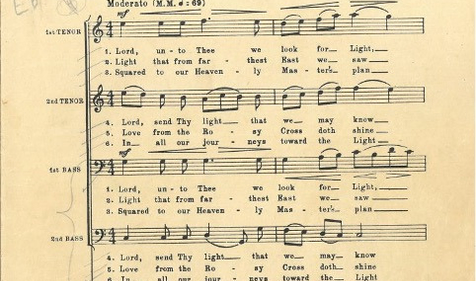As Masons, we are used to seeing the square and compasses symbol. Whether we are identifying it while passing a Masonic building or proudly pinning it to our suit, this Masonic emblem is forever imprinted on our minds. Learn more about this Masonic symbol and its origins in our newest blog.
As Masons, we are used to seeing the square and compasses symbol. Whether we are identifying it while passing a Masonic building or proudly pinning it to our suit, this Masonic emblem is forever imprinted on our minds. There is no doubt that “The square and compass is the single most universally identifiable symbol of Freemasonry.”
Origin of the Symbol
The exact origin of the square and compasses symbol (or more accurately, a square and set of compasses joined together) is unknown. The symbol’s origin is theorized to have come from the stonemasons’ guilds during the middle ages. In fact, most language and symbolism used in our fraternity comes from this era.
Seen on numerous structures around the world, the square and compasses symbol with a G in the middle instantly marks a building as a Masonic entity. The start of this Freemasonry logo dates as far back as the 1780s, but its earliest known appearance, without any Masonic context, can be found in a book that was printed in the early sixteenth century. However, most Masonic scholars do not consider this relic to have any connection to Freemasonry.
The compass in the square and compasses came from the idea of “keeping within compass” which is from an old rhyme: “By honest and industrious means, we live a life of ease, then let the Compass be your guide and go where’er you please.” In the 1700s, this phrase and ideology was widely known, and there were many objects such as teapots, plates, and engravings that adopted this symbology as decoration without any connection to Freemasonry. “Keeping within compass” meant that you were on the right path and behaving in the proper fashion. The fraternity soon after adopted this theme, and it has become the basis for the standardization of Masonic values today.
Meaning of the Square and Compasses
The entire square and compasses as a whole is said to have a number of different meanings, representing a combined sense of judgement, balance, and stability. Derived from the working tools of Stonemasons, the symbol shows an architect's tool and is meant to serve as a metaphor for how the teachings of Freemasonry help to "build" members into better men.
The Letter "G"
The infamous letter "G" most often found in the center of the Masonic compass holds a multitude of meanings. To start, it represents geometry, a mathematical concept critical to the work of Stonemasons from which modern Freemasonry derives. Geometry is known to uncover the relationship of objects and the wonders of nature, which aligns with the principles of the craft. Throughout the degrees of Freemasonry and the Scottish Rite, the tools of Stonemasons and the principles of geometry are used to inform the lessons the craft bestows upon members.
Secondly, the "G" is also thought to represent God, or the Grand Architect of the Universe. While Freemasonry is not affiliated with any individual religion, a core requirement of membership is the belief in a God. The letter G in the square and compass is intended to also remind Masons that our lives and actions are witnessed in the presence of God or the Grand Architect. You can learn more details about the Masonic letter G at our blog.
The Square and Compass
In the operative Stonemason era, the 90 degree angle of the square was a critical tool used to test the accuracy of the sides of a stone to ensure that the stone's angles matched the square's "true" right angle. Today, the square and compass pay homage to early tradition by representing morality and boundaries, respectively.
The square promotes abiding by the craft's core values as Masons "square our actions by the square of virtue with all mankind," while the compass similarly is an emblem that signifies our wisdom of conduct as Masons "circumscribe our desires and keep our passions within due bounds."
The square and compass, when placed together with the letter "G" at the center to represent the focal point, serves as a visual representation of the principles Masons abide their lives by.
The Square and Compasses Today

There is no doubt that the square and compasses Masonic symbol is transcendent in nature and has stood for a tradition and set of values that has remained stationary throughout time. This symbol can be found all over the world on buildings, pin lapels, promotional items, book covers, and Masonic regalia such as aprons, chapter pennies, hats, and gloves. It truly is a symbol that unites the fraternity all over the globe and shares a promise of justice, truth, and Brotherhood.
Interested in purchasing Masonic gear featuring the square and compass? Check out the Masonic Marketplace.
Research material provided by the Scottish Rite Museum & Library via the work below:
Philalethes, Volume 65, No. 3, summer 2012, Developing a Symbol, The Square and Compass with the Letter G in American Freemasonry, Aimee Newell
Related Stories
Discover additional Scottish Rite blogs and news on this topic.



